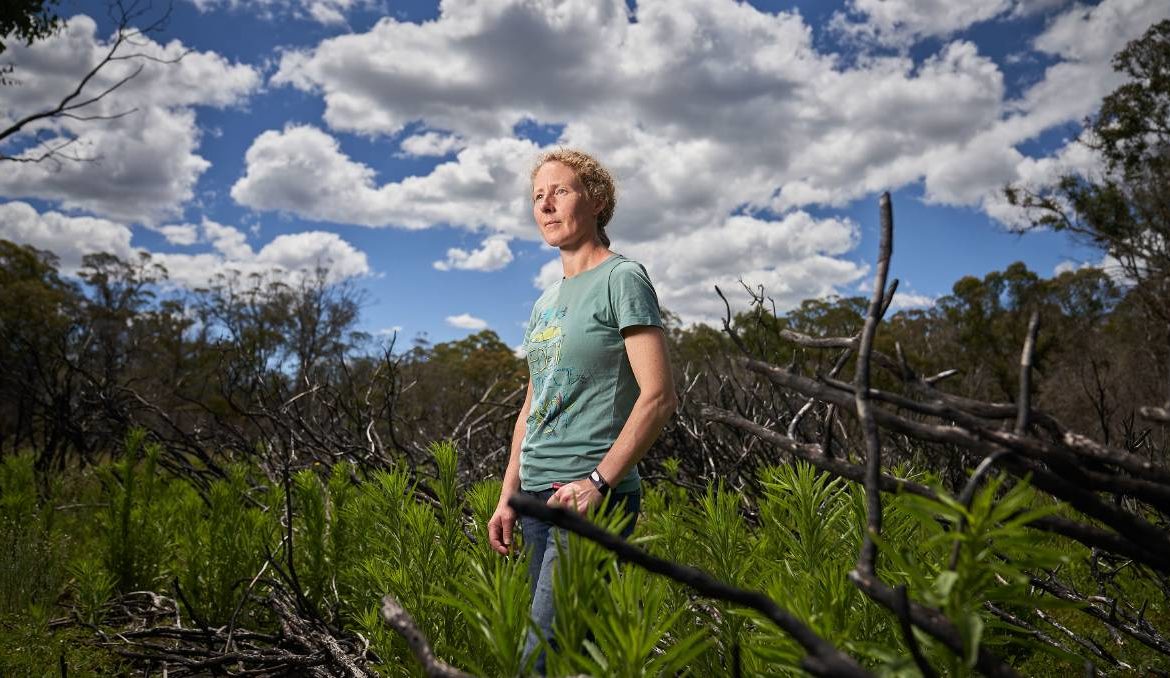news, environment, greater glider
When the fires swept over Karen Ford’s property at Forbes Creek just over a year ago, the landscape couldn’t have looked blacker or bleaker. The habitat of one of Australia’s most amazing animals was scorched earth after a firestorm had swept through. At the time, Dr Ford found 15 dead greater gliders which had made their home near her home on the fringe of the Tallaganda National Park, south-east of Canberra. The future of the marsupial seemed literally burnt out. Fast-forward a year, and the adorable night animal is back. The blackness of the ash on the landscape on which it depends is now punctuated by greenery. Hope is back. “We’ve definitely seen some gliders now, and that’s really encouraging,” the Australian National University ecologist said. The glider is best described as a possum crossed with a polar bear. It’s like a koala that can fly – or, at least, glide from high boughs on trees to lower ones. It’s been called a “ringtail possum in drag”, with a big fluffy fur coat on a very small body. It has big, round eyes. The gliders are nocturnal, and Dr Ford now goes out with a torch at night and spots them. What seemed dead a year ago is coming back to life. “I do feel like it gives you hope when you see things recovering – when you see animals again,” Dr Ford said. It is all a huge change in atmosphere from the aftermath of when the North Black Range bushfire did its worst. The dead gliders Dr Ford found then were unburnt. They appeared to have died from starvation or dehydration. They are herbivores which live on eucalypts and are very dependent on particular ecologies. When the fragile ecosystems are burnt, their means of survival vanish. Their fate highlights how hard it is to help sensitive populations recover from bushfires. But they are recovering. They do not yet reach the numbers that existed before the fires, but their numbers are increasing. Dr Ford said some of the scorched earth has not recovered, so the population remains restricted. “We’ve had a lot of rain since last year. It took a long time to start growing back and there are areas which haven’t recovered. There are some trees which are not going to to be growing – they’ve been killed by the fires.” But in other areas, there is some ground cover – and that is allowing animals to reclaim life. Dr Ford has also been heartened by finding koalas and possums in the burnt-out area. “You still find animals. The fact that some are able to cling on and they stay there, and as the bush recovers, it makes you think that things will recover. “It just takes a while.” It was estimated more than 1 billion animals died in the fires since September 2019, with millions of hectares burnt across south-eastern Australia.
/images/transform/v1/crop/frm/steve.evans/b9f12eb0-141c-4cc4-bef1-2597e12a1888.jpg/r2_153_2998_1846_w1200_h678_fmax.jpg
When the fires swept over Karen Ford’s property at Forbes Creek just over a year ago, the landscape couldn’t have looked blacker or bleaker.
The habitat of one of Australia’s most amazing animals was scorched earth after a firestorm had swept through.
At the time, Dr Ford found 15 dead greater gliders which had made their home near her home on the fringe of the Tallaganda National Park, south-east of Canberra.
The future of the marsupial seemed literally burnt out.
Fast-forward a year, and the adorable night animal is back. The blackness of the ash on the landscape on which it depends is now punctuated by greenery. Hope is back.
“We’ve definitely seen some gliders now, and that’s really encouraging,” the Australian National University ecologist said.
The glider is best described as a possum crossed with a polar bear. It’s like a koala that can fly – or, at least, glide from high boughs on trees to lower ones.
It’s been called a “ringtail possum in drag”, with a big fluffy fur coat on a very small body. It has big, round eyes.
The gliders are nocturnal, and Dr Ford now goes out with a torch at night and spots them. What seemed dead a year ago is coming back to life.
“I do feel like it gives you hope when you see things recovering – when you see animals again,” Dr Ford said.
Dr Karen Forbes one year ago. Picture: Karleen Minney
It is all a huge change in atmosphere from the aftermath of when the North Black Range bushfire did its worst.
The dead gliders Dr Ford found then were unburnt. They appeared to have died from starvation or dehydration.
They are herbivores which live on eucalypts and are very dependent on particular ecologies. When the fragile ecosystems are burnt, their means of survival vanish.
Their fate highlights how hard it is to help sensitive populations recover from bushfires.
But they are recovering. They do not yet reach the numbers that existed before the fires, but their numbers are increasing.
Dr Ford said some of the scorched earth has not recovered, so the population remains restricted.
“We’ve had a lot of rain since last year. It took a long time to start growing back and there are areas which haven’t recovered. There are some trees which are not going to to be growing – they’ve been killed by the fires.”
But in other areas, there is some ground cover – and that is allowing animals to reclaim life.
Dr Ford has also been heartened by finding koalas and possums in the burnt-out area.
“You still find animals. The fact that some are able to cling on and they stay there, and as the bush recovers, it makes you think that things will recover.







